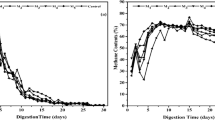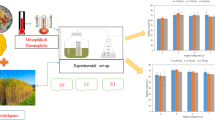Abstract
Management of solid organic waste has become a major challenge in developing countries. Raw solid organic waste can be converted into biogas through anaerobic digestion; however, the efficiency of the process is influenced by various factors including the composition of the substrate. The present study was designed with the objective of enhancing the biodegradability of the organic fraction of municipal solid waste (OFMSW) and biogas production through co-digestion of the substrate with melon residues. The study was conducted in batch mode in four phases. The results revealed that an addition of melon waste at the rate of 300 g kg−1 OFMSW substantially increased the biodegradation rate and biogas production compared to OFMSW alone. The removal of up to 57.2 % volatile solids and a carbon to nitrogen (C/N) ratio of 15.9 was achieved at a 60 % water level when the digestion mixture was treated with inocula collected from partially-degraded food waste. The findings of this study reveal that melon residues could be used as a potential co-substrate to enhance the biodegradability of OFMSW and biogas production.






Similar content being viewed by others
References
Nayono SE, Gallert C, Winter J (2010) Co-digestion of press water and food waste in a biowaste digester for improvement of biogas production. Bioresour Technol 101:6987–6993
Hanc A, Novak P, Dvorak M, Habart J, Svehla P (2011) Composition and parameters of household bio-waste in four seasons. Waste Manag 31:1450–1460
Zhang L, Lee Y, Jahng D (2011) Anaerobic co-digestion of food waste and piggery wastewater: focusing on the role of trace elements. Bioresour Technol 102:5048–5059
Han SK, Shin HS (2004) Biohydrogen production by anaerobic fermentation of food waste. Int J Hydrogen Energy 29:569–577
Munster M, Lund H (2010) Comparing waste-to-energy technologies by applying energy system analysis. Waste Manag 30:1251–1263
Khalid A, Arshad M, Anjum M, Mahmood T, Dawson L (2011) The anaerobic digestion of solid organic waste. Waste Manag 31:1737–1744
Fricke K, Santen H, Wallmann R, Huttner A, Dichtl N (2007) Operating problems in anaerobic digestion plants resulting from nitrogen in MSW. Waste Manag 27:30–43
Heo N, Park S, Lee J, Kang H, Park D (2003) Single-stage anaerobic codigestion for mixture wastes of simulated Korean food waste and waste activated sludge. Appl Biochem Biotechnol 107:567–579
Zhang R, El-Mashad HM, Hartman K, Wang F, Liu G, Choate C, Gamble P (2007) Characterization of food waste as feedstock for anaerobic digestion. Bioresour Technol 98:929–935
Braun R, Brachtl E, Grasmug M (2003) Codigestion of proteinaceous industrial waste. Appl Biochem Biotechnol 109:139–153
Ashekuzzaman SM, Poulsen TG (2011) Optimizing feed composition for improved methane yield during anaerobic digestion of cow manure based waste mixtures. Bioresour Technol 102:2213–2218
Monnet F (2003) an introduction to anaerobic digestion of organic waste. Final Report, Remade Scotland, UK
El-Mashad HM, Zhang R (2010) Biogas production from co-digestion of dairy manure and food waste. Bioresour Technol 101:4021–4402
Cuetos MJ, Gomez X, Otero M, Moran A (2008) Anaerobic digestion of solid slaughterhouse waste (SHW) at laboratory scale: influence of co-digestion with the organic fraction of municipal solid waste (OFMSW). Biochem Eng J 40:99–106
Lin J, Zuo J, Gan L, Li P, Liu F, Wang K, Chen L, Gan H (2011) Effects of mixture ratio on anaerobic co-digestion with fruit and vegetable waste and food waste of China. J Environ Sci 23:1403–1408
Alkaya E, Demirer GN (2011) Anaerobic mesophilic co-digestion of sugar-beet processing wastewater and beet-pulp in batch reactors. Renew Energy 36:971–975
Wan C, Zhou Q, Fu G, Li Y (2011) Semi-continuous anaerobic co-digestion of thickened waste activated sludge and fat oil and grease. Waste Manag 31:1752–1758
Bakhsh K, Ahmad B, Gill ZA, Hassan S (2006) Estimating indicators of higher yield in radish cultivation. Int J Agric Biol 6:783–787
Sharif M, Farooq U, Malik W (2005) Citrus marketing in Punjab: constraints and potential for improvement. Pak Dev Rev 44:673–694
MRRD (2007) Feasibility study for melon subsector plan: improved sorting, grading and boxing of melons for export. http://afghanag.ucdavis.edu/a_horticulture/row-crops/melons/reports-melons/Melons_Feas_study_for_sorting_and_packing_co.pdf/view
Parawira W, Murto M, Zvauya R, Mattiasson B (2004) Anaerobic batch digestion of solid potato waste alone and in combination with sugar beet leaves. Renew Energy 29:1811–1823
Weiland P (2006) State of the art of solid-state digestion—recent developments. In: Rohstoffe FN (ed) Solid-state digestion—state of the art and further R&D requirements, Gulzower Fachgespräche, pp 22–28
Yetilmezsoy K, Sakar S (2008) Development of empirical models for performance evaluation of UASB reactors treating poultry manure wastewater under different operational conditions. J Hazard Mater 153:532–543
Budiyono I, Widiasa N, Johari S, Sunarso (2010) The influence of total solid contents on biogas yield from cattle manure using rumen fluid inoculum. Energy Res J 1:6–11
Smith AD, Holtzapple MT (2011) Investigation of the optimal carbon–nitrogen ratio and carbohydrate-nutrient blend for mixed-acid batch fermentations. Bioresour Technol 102:5976–5987
EPA (2001) Total, fixed, and volatile solids in water, solids, and biosolids (Method 1684). US Environmental Protection Agency, Washington, USA
ASTM (2004) Nitrogen in the analysis sample of refuse-derived fuel (E778–87). ASTM International, West Conshohocken
Anderson JM, Ingram JSI (1993) Colorimetric determination of nitrogen and phosphorous tropical soil bio and fertility. A handbook of methods. CAB International, Wallingford, pp 73–74
Banks CJ, Chesshire M, Heaven S, Arnold R (2011) Anaerobic digestion of source segregated domestic food waste: performance assessment by mass and energy balance. Bioresour Technol 102:612–620
Kivaisi AK, Mtila M (1998) Production of biogas from water hyacinth (Eichhornia crassipes) (Mart) (Solms) in a two-stage bioreactor. World J Microbiol Biotechnol 14:125–131
Chen Y, Cheng JJ, Creamer KS (2008) Creamer inhibition of anaerobic digestion process: a review. Bioresour Technol 99:4044–4064
Alvarez J, Otero AL, Lema JM (2010) A methodology for optimising feed composition for anaerobic co-digestion of agro-industrial wastes. Bioresour Technol 101:1153–1158
Mshandete A, Kivaisi A, Rubindamayugi M, Mattiasson B (2004) Anaerobic batch co-digestion of sisal pulp and fish wastes. Bioresour Technol 95:19–24
Lastella G, Testa C, Notornicola GM, Voltasio F, Sharma VK (2002) Anaerobic digestion of semi-solid organic waste: biogas production and its purification. Energy Convers Manag 43:63–75
Briski F, Vukovic M, Papa K, Gomzi Z, Domanovac T (2007) Modelling of composting of food waste in a column reactor. Chem Pap 61:24–29
Fernandez J, Pérez M, Romero LI (2010) Kinetics of mesophilic anaerobic digestion of the organic fraction of municipal solid waste: influence of initial total solid concentration. Bioresour Technol 101:6322–6328
Berriel MCH, Benavides LM, Perez DJG, Delgado OB (2008) The effect of moisture regimes on the anaerobic degradation of municipal solid waste from Metepec (Mexico). Waste Manag 28:14–20
Bouallagui H, Cheikh RB, Marouani L, Hamdi M (2003) Mesophilic biogas production from fruit and vegetable waste in tubular digester. Bioresour Technol 86:85–89
Forster-Carneiro T, Perez Garcia M, Romero García LI, Sales D (2007) Dry thermophilic digestion of organic fraction of the municipal solid waste: focusing on the inoculum sources. Bioresour Technol 98:3195–3203
Author information
Authors and Affiliations
Corresponding author
Rights and permissions
About this article
Cite this article
Anjum, M., Khalid, A., Mahmood, T. et al. Anaerobic co-digestion of municipal solid organic waste with melon residues to enhance biodegradability and biogas production. J Mater Cycles Waste Manag 14, 388–395 (2012). https://doi.org/10.1007/s10163-012-0082-9
Received:
Accepted:
Published:
Issue Date:
DOI: https://doi.org/10.1007/s10163-012-0082-9




